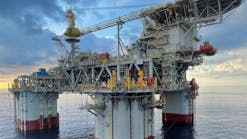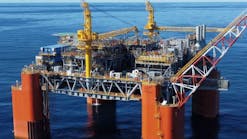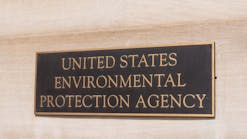Mohammad AL-Gailani
GeoDesign Ltd.
Kingston-upon-Thames, England
Iraq is probably one of the least explored countries in the Middle East, despite the fact that it possesses one of the richest hydrocarbon basins in the world almost on a par to Saudi Arabia's potential, if not more.
The aim of this article is to state the facts about Iraq and focus on the huge but untapped and undeveloped hydrocarbon resources to the international oil community. Perhaps it is best to start by describing briefly the sedimentary and tectonic elements responsible for accumulating such large hydrocarbon resources.
Basin, tectonic elements
Virtually all the 440,000 sq km of Iraq is part of the North Arabian sedimentary basin extending from the Arabian-Nubian platform in the west and the Alpine folded geosynclinal units of the foredeep in the east. This vast sedimentary basin dates from the Precambrian and has a sedimentary thickness of over 50,000 ft from Cambrian to recent.
Several episodes of orogenic movements affected this vast sedimentary basin starting from late Proterozoic and early Infracambrian Hijaz and Najd orogenes and progressing to the Caledonian and Hercynian orogenic folding resulting in early east-west trending basin with miogeosynclinal character developing throughout the Paleozoic times occasionally characterized by north-south and northeast-southwest trending uplift features.1 East-west trending uplift features were characteristic of early Devonian and late Carboniferous times resulting in a deficiency of sediments during those times. However, continuous basinal development around the northern Arabian platform had been renewed starting from Permian and resulting in thick and virtually uninterrupted sedimentary cover.
The Alpine Tethys geosyncline began in early Triassic where parts of the Iranian platform split from the northern Arabian platform along weak systems of faults. This geosynclinal system migrates through the northern Arabian platform as a progressive subduction of the Arabian plate beneath the Iranian plate commencing with the Kimmerian orogeny in the late Jurassic and culminating with the Zagros crush zone or imbricated zone.2 This resulted in complex duplex fold and fault structures along a narrow northwest-southeast and marked by eugeosynclinal volcanic activities during Cretaceous-Paleogene times, while the northern edge of the Arabian platform (where Iraq is situated) is marked by external miogeocynclinal sediments.
The Arabian platform is subdivided into a stable part called the Stable Platform and a mobile one called the Unstable Platform. The Stable Platform is characterized by tectonic stability with relatively reduced sedimentary cover which is bordered by flexure faults with block faulted zones such as the Ga'ara Block, Abu Jir, and Shbicha subzones. The Mobile Platform is more active and characterized by thick sedimentary cover and can be subdivided by their sedimentary structures into:
- The Mesopotamian Zone: characterized by monoclinal structures gently dipping toward the northeast marked by rapid subsidence since at least Mesozoic time.
- The Foothill Zone: marked by thick sedimentary cover with long anticlinal folds arranged in narrow belts separated by broad flat synclines.
- The Highly Folded Zone: characterized by intensive folding with closely packed narrow anticlines separated by narrow synclines.
The Mobile Platform adjoins the zone of major overthrusting which is divided into the imbricated zone and the Zagros thrust zone. The imbricated zone is characterized by thrust folded structures and overthrusted blocks; while the Zagros thrust zone is composed of sediments thrusted over the tectonic zone of north Iraq.
The majority of the structural styles in Iraq exhibit a northwest-southeast and east-west trending folded belt and are widely regarded as the result of the counter-clockwise northeast rotational drift of the Afro-Arabian plate which is subducted below the Iranian plate to the Northeast.
Structural anomalies
Some 526 known structures have been discovered, delineated, mapped, and recorded with proper names and numbers enough to be classified as potential hydrocarbon prospects with identifiable closure. The majority of these structures are subsurface anticlinal elongated multi-domal structures with individual domes varying in size and styles and ranging from 1 km to 74 km in length. There are even multiple domal structures reaching up to 115 km in length. However, almost one third of these structures exhibit different styles ranging from oval to circular in nature. The various structural closures can be divided according to their prospects and tectonic settings (Fig. 1 [30000+ bytes]) as follows:
A-Near geosynclinal flank of the Mesopotamian foredeep prospects
Over 100 prospects have been identified in this zone. The majority are long anticlinal surface structures of different prospectivity separated by wide synclines. Forty- nine structures are over 20 km long reaching up to 74 km at Chemchemal field. Some of these anticlines have been tested while the majority are still awaiting drilling. Among the successfully tested and proven fields are Sufaiyah, Ainzalah, Butmah, Demirdagh, Chemchemal, Chia Surkh, Taq Taq, and giant Kirkuk field.
B-Central faulting zone prospects
Nearly 110 prospects have been delineated in this zone. Some of the structures are of Tertiary prospectivity with very interesting potential discoveries while the remainder exhibit Tertiary and Cretaceous and Cretaceous and Triassic potential. Nearly 25 prospects are over 20 km long reaching over 50 km at Makhul and Sinjar structures.
Various play-fairways have been identified in this zone within the Tertiary prospects which could have far reaching implications for future exploration in Iraq. Substantial columns of net pays have been tested along the flanks and in nearby synclines in duplex structures adding a new dimension to the exploration potential of these prospects. Among the tested proven field discoveries are Fauqi, Abu Ghirab, Tel Ghazal, Naft Khana, Mandali, Mansuria, Khashim Ahmar, Gilabat, Pulkhana Jambur, Himreen, Khabaz, Bai Hasan, Qara Chauq, Khanuqah, Najmah, Qaiyarah, Qasab, and Alan ... the list goes on.
C-Near platform flank of the Mesopotamian foredeep prospects
The most prominent feature in this zone is the Anah graben extending over 215 km where only two boreholes have been drilled. Other grabens such as Khlesia (130 km) and Tayarat (60 km) have not been explored yet. These grabens are considered natural extensions to the Euphrates graben in Syria where over 38 commercial oil accumulations have yielded nearly 400,000 b/d.3 In the remainder of this zone, 160 prospects have been identified and delineated. The majority are Cretaceous targets with long elongated anticlinal traps separated by broad synclines, while the rest are of Triassic and Paleozoic prospectivity. Some of the Cretaceous prospects have proven to be giant discoveries with multipay zones such as Rumaila, Majnoon, Nahr Umr, and Halfaya with long axes stretching more than 30 km to over 115 km in East Baghdad field.
D-Northeastern slope of African-Arabian stable platform prospects
This area roughly constitutes one third of Iraq with approximately 150,000 sq km still to be assessed. There are about 155 prospects ranging in size from 1 km to 46 km at the Shamat structure with one major discovery in the Paleozoic at Akkas where the structure is over 27 km long.
The targets are all Triassic and Paleozoic prospects, nearly 7 of them are over 20 km long and considered enormous by any standard. The majority of these targets exhibit variable shapes and sizes ranging from circular to oval sub-rounded and crescent type features. There are only 10 wells drilled in this zone. Among the major finds are at Abu Khema, Diwan, Samawa, Ekhaidher, and Akkas.
Deep drilling
So far out of the 526 prospects delineated, only 125 have been drilled representing about 20% of the total prospects found to date.
The total number of deep tests drilled in Iraq is around 59 wells. Of these 39 have reached the Jurassic, 12 reached Triassic, four the Permian, one Carboniferous, and three the Ordovician.
One can easily conclude from the above account that large parts of the country are still virgin with huge untapped resources still awaiting development and exploitation.
Source rocks
Until recent years, no one had paid much attention to the quality and richness of source rocks in Iraq. Recently, Al-Habba and Abdullah4 and Al-Habba et al.5 published the first recorded work on various source rocks from the north and west of the country. Analysis has shown numerous and prolific source rock characterization in Iraq (Table 1 [24440 bytes]).
Al-Habba and Abdullah4 calculated the possible generated hydrocarbon reserves from the north of the country for both the Cretaceous Balambo and the Jurassic source rocks. They estimated that the Balambo had generated what is equivalent to 13 billion bbl of oil, while the Jurassic formations had generated an equivalent of 18 billion bbl of oil with a total oil generating capacity exceeding 31 billion bbl for an area of 75,000 sq. km. While in the western desert, Al-Habba et al.5 concluded that from an average thickness of the Silurian "Hot Shale" of 65 m with an average organic content of 6%; the estimated generated hydrocarbons for an area of 20,000 sq km between Akkas and Khleisia would be around 16 billion bbl. The existence of the Silurian source rock throughout the western region of Iraq with TOC values reaching up to 16.6% and hydrocarbon yield of 49 kg/ton is probably one of the richest in the world.
The discovery of Majnoon field with its 10 pay zones, each with varying API ranging from 40° to 25° suggests multiple source rocks within the Cretaceous sequence with varying degrees of maturity.
Reservoir rocks
Iraq contains about 47 identifiable reservoirs, ranging in age from Miocene to Ordovician, that can be considered as potential targets for future exploration. Table 2 [49596 bytes] summarizes all the known reservoirs to date with the number of fields actually found. Clearly, the Zubair sandstone of Aptian-Hautervian age is the most prolific reservoir in Iraq found in nearly 27 fields, followed by Yamama in 16 fields, and Shiranish and Mishrif in 13 fields.
New potential discoveries in the Yamama of Lower Cretaceous as well as in the Jurassic Najmah and Mus in the southern fields have added a new, exciting pros- pect. The Triassic Butmah in the north is yet to be developed while exciting finds in the Kurra Chine (Triassic), Chia Zairi (Permian), Ga'ara (Carboniferous), Harur (L. Carboniferous), Akkas (Silurian) and Khabour (Ordovician) are yet to be targeted, explored, tested, and developed.
All of the discovered fields are multipay zone fields (Table 3 [16340 bytes]) with around two to four pay zones in each field and reaching up to 10 pay zones at Majnoon field, where the reservoir ages range from Miocene to Lower Cretaceous; marking the deepest target reached in this field. Further deeper prospects are yet to be tested. The Jurassic Najmah has proven to be a prolific reservoir in some of the southern fields with high API gravity and very low sulfur content. On average most of the giant oil fields discovered so far such as Kirkuk, Bai Hassan, Rumaila, Zubair, and Ratawi have at least five pay zones each.
Reservoirs in Iraq that lie within 2,000 ft constitute around 30-40%; while the remaining 60% lie within 10,000 ft. The recent Paleozoic discovery at Akkas was around 12,000 ft.
Characteristics
Most Iraqi reservoirs have excellent reservoir characteristics with good porosities and permeabilities, sometimes coupled with extensive fracturing and jointing. Table 4 [49394 bytes] summarizes the characteristics of some of the reservoirs and the range of API and sulfur content of the reservoirs. This figure clearly shows that the older the reservoirs the better API and lower sulfur content. Some of the Tertiary Kirkuk group reservoirs exhibit prolific test flow rates reaching up to 120,000 b/d from Kirkuk-104 and Kirkuk-164. This is probably the highest flow rate ever recorded anywhere in the world.
New reserves
Recent proprietary studies on proven, discovered oil, and gas reserves made by GeoDesign (from over 74 undeveloped prospects comprising more than 230 new pay zones) found that oil in place was in excess of 321.524 billion bbl. The gas in place, comprising associated and free gas, is estimated at 168,401,174 million cu m. The remaining undiscovered potential is probably as large with vast areas of the country (around 150,000 sq km) still not explored yet. Most of the existing oil fields discovered by IPC possess reservoirs that have been completely overlooked and bypassed. It was customary to target the Tertiary reservoirs (Kirkuk Group) in the north and the Cretaceous Zubair in the southern fields. However, potential targets such as the Middle Cretaceous Qumchuqa in the north and the Upper Cretaceous Hartha, Sadi, Tanuma, and Khasib and the Middle Cretaceous Mishrif formations possess huge potential in the center and south. Recent discoveries of oil in the Yamama formation in the southern fields have added a new pay zone. The Jurassic Najmah is another new reservoir in the southern fields showing very promising results with oil reaching up to 49° API and with very low sulfur content. Exciting finds in the Khabour (Ordovician) at Akkas have added another dimension to the oil exploration in Iraq.
Summary, conclusions
It is clear from the above account that Iraq has huge untapped hydrocarbon reserves yet to be developed to their full potential. While most of the other Middle East countries are exploiting their reserves, Iraq remains relatively undeveloped.
One hopes and prays that Iraq will open soon to the international oil exploration companies to develop this huge potential with open and fair competition allowing oil companies to apply their latest technological know-how; thus participating in further exciting hydrocarbon discoveries.
Acknowledgment
The author acknowledges the numerous Iraqi geologists, scientists, and engineers whose names cannot be mentioned and who contributed to the discovery and development of all the Iraqi fields.
References
1. Buday, T., and Jassim, S., The Regional Geology of Iraq, Vol. 2, Tectonism, Magnetism, and Metamorphism, State Establishment of Geological Survey & Mineral Investigation, Baghdad, 1987, 352 p.
2. Stocklin, J., Structural history and tectonics of Iran: a review, AAPG Bull., Vol. 52, 1968, pp. 1,229-58.
3. de Ruiter, R.S.C., Lovelock, P.E.R., and Nabulsi, N., The Euphrates Graben of eastern Syria: A new Petroleum Province in the northern Middle East, GEO 94, The Middle East Geoscience conference, Bahrain, Vol. 1, 1994, pp. 357-368.
4. AL-Habba, Y., and Abdullah, M., Geochemical study of the hydrocarbon source rocks from the northeast of Iraq, Oil and Arab Cooperation, Vol. 15, No. 57, 1989, pp. 11-50 (in Arabic).
5. AL-Habba, Y, AL-Samarrai, A., AL-Jubouri, F., Gorgies, N., and Ahmed, E. M., Hydrocarbon potential of the Paleozoic rocks from western Iraq according to the results obtained from well Akkas-1, Organization of Arab Petroleum Exporting Countries, Cairo, 1994.
The Author
Mohammad AL-Gailani is managing director of GeoDesign Ltd., a London consultancy office specializing in databases of the Middle East. He graduated from Baghdad University in 1972 with a BSc in geology and worked briefly for Iraq National Oil Co. in Baghdad. He won a scholarship in 1973 for post-graduate studies in petroleum geology where he obtained first his MSc in 1974 from University of Aberdeen and then PhD and DIC in January 1979 from Imperial College, London. He worked as a consultant on projects in the Middle East and Parana basin in South America, where he worked for Pauli Petro, Sao Paulo, Brazil.
Copyright 1996 Oil & Gas Journal. All Rights Reserved.


